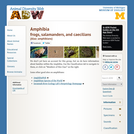
Amphibia: Information
- Subject:
- Life Science
- Zoology
- Material Type:
- Reading
- Provider:
- University of Michigan Museum of Zoology
- Provider Set:
- Animal Diversity Web
- Date Added:
- 03/07/2005

Amphibia: Information

Biology is designed for multi-semester biology courses for science majors. It is grounded on an evolutionary basis and includes exciting features that highlight careers in the biological sciences and everyday applications of the concepts at hand. To meet the needs of today’s instructors and students, some content has been strategically condensed while maintaining the overall scope and coverage of traditional texts for this course. Instructors can customize the book, adapting it to the approach that works best in their classroom. Biology also includes an innovative art program that incorporates critical thinking and clicker questions to help students understand—and apply—key concepts.


By the end of this section, you will be able to:Describe the important difference between the life cycle of amphibians and the life cycles of other vertebratesDistinguish between the characteristics of Urodela, Anura, and ApodaDescribe the evolutionary history of amphibians


This resource is a video abstract of a research paper created by Research Square on behalf of its authors. It provides a synopsis that's easy to understand, and can be used to introduce the topics it covers to students, researchers, and the general public. The video's transcript is also provided in full, with a portion provided below for preview:
"Amphibians are one of the most vulnerable animal groups on the planet, with over 40% of their species threatened with extinction. A major driver of that vulnerability is the fungal pathogen _Batrachochytrium dendrobatidis_ (Bd). Bd is linked to the decline of at least 500 amphibian species, the greatest loss in biodiversity due to a pathogen ever recorded. The amphibian skin microbiome community structure has been linked to health outcomes of Bd infection, but the functional importance of the microbiota is not yet fully understood. To close this gap and potentially discover biomarkers or disease control methods, researchers investigated the microbiome of midwife toads. They examined both wild populations with naturally occurring Bd infection and controlled laboratory exposure. Infection with Bd led to changes in the microbial community structure, gene profile, and metabolic function in laboratory and wild toad populations..."
The rest of the transcript, along with a link to the research itself, is available on the resource itself.